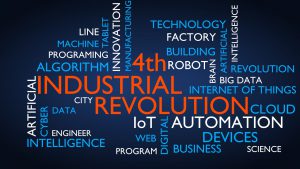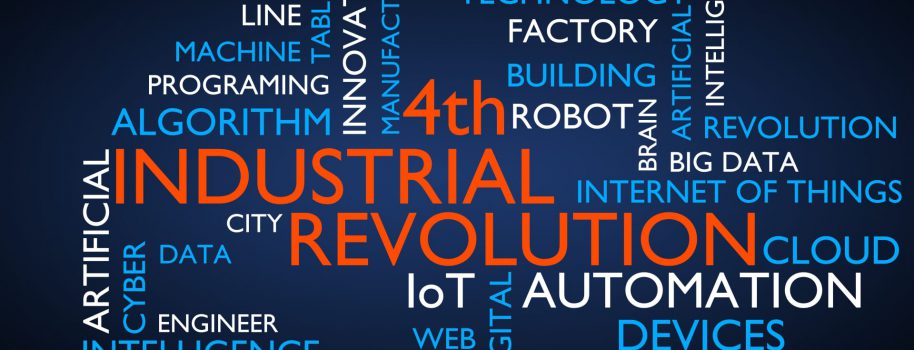 The Fourth Industrial Revolution, also called the 4IR or Industry 4.0, builds on foundations laid by the first three industrial revolutions.
The Fourth Industrial Revolution, also called the 4IR or Industry 4.0, builds on foundations laid by the first three industrial revolutions.
The first one saw the advent of the steam engine in the 18th century , allowing production to be mechanized for the first time and driving social change as people became increasingly urbanized. In the second industrial revolution, electricity and other scientific advancements led to mass production. In the 1950s, the third industrial revolution took place and the world saw an emergence of computers and digital technology. This led to the increasing automation of manufacturing and the disruption of industries including banking, energy, and communications. [1]
The “Fourth Industrial Revolution” is a term coined by Klaus Schwab in the context of the 2016 World Economic Forum: “Like the revolutions that preceded it, the Fourth Industrial Revolution has the potential to raise global income levels and improve the quality of life for populations around the world.” Schwab is the founder and executive chairman of the World Economic Forum. He also suggested that the 4IR could lead to greater inequality, with a potential to disrupt labor markets which could escalate social tensions.
Technologies that are driving change as part of the 4IR include artificial intelligence, block chain, faster computer processing, virtual and augmented reality, biotechnology, robotics, internet of things, and 3D printing, among others. [2] They have a major impact on businesses who will need to ensure they have the right mix of skills in their workforce to keep pace with changing technology. If businesses continue in the current trajectory, it will not benefit the majority of the world.
One challenge that we can foresee is that the introduction of new technologies makes it cheaper and more effective for machines to do those jobs that historically have been done by humans. To put it simple, machines could replace humans at certain jobs. In 2019, Amazon added machines to their warehouses that pack orders, replacing humans who traditionally did the job and removing 1300 jobs across 55 U.S. fulfillment centers. [3] The machines pack 600 to 700 boxes per hour, four to five times the rate of a human packer.
A second challenge is equipping our education systems to provide the skills required for the 4IR and better prepare children and young people to have the agency and opportunity as they enter the workforce. A third challenge is cybersecurity, as the 4IR implies the free flow of data and information of consumers, which leads to privacy concerns and putting in place regulatory requirements to protect customers and businesses. The publication of the General Data Protection Regulation (GDPR) by the European Union (EU) in 2016 introduced new regulations in EU law on data protection and privacy in the EU and the European Economic Area. [4]
However, predicting how the 4IR will impact the development sector and the global south remains difficult. For example, a basic indicator for the roll out of Information and Communication Technology (ICT) could be the amounts of mobile phone subscriptions. By the end of 2016, around 66% of the world population had one (individual users, not sim cards). Furthermore, the amount of individuals that accessed the internet in 2021 has doubled since 2017, reaching 3.6 billion people today. [5]
While data is pivotal to estimate the changes we may be facing in the next few years, context remains a very important qualitative indicator that always needs to be considered. For example, on a global level, women are 10% less likely to own a phone than men, while this situation differs in some regions: In South Asia, for example, women are 26% less likely to own a mobile than men, and 70% are less likely to go on the Internet. Multiple factors, including race, gender, religion, class, can be considered responsible of limiting access in a given context. [6]
Keeping in mind the above core challenges, governments, civil society and the development sector need to think of investing in preparing all stakeholders for the 4IR. Hence, the ultimate aim is to improve living standards and job opportunities for all, trying to avoid exacerbating the differences already perceived in the development realm. How do you think challenges should be addressed, in particular in the development sector?
[1] https://www.salesforce.com/blog/what-is-the-fourth-industrial-revolution-4ir/
[3] https://www.reuters.com/article/us-amazon-com-automation-exclusive-idUSKCN1SJ0X1
[4] https://eur-lex.europa.eu/eli/reg/2016/679/ojhttps://eur-lex.europa.eu/eli/reg/2016/679/oj
[5] [6] Geoff Walsham (2017), ICT4D research: reflections on history and future agenda, Information Technology for Development, p. 37

